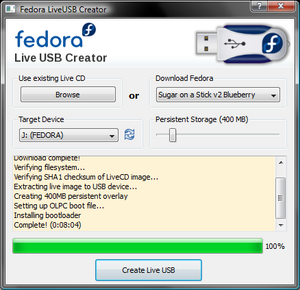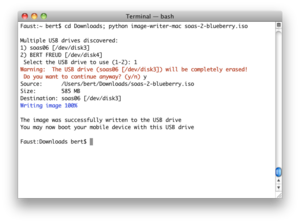SoaS Blueberry Instructions
For Windows Users
|
For GNU/Linux Users
Linux Users will use a slightly different approach than Windows Users to ensure maximum compatibility with different distributions. Please follow the instructions carefully to ensure your data is preserved.
If you are a Fedora User, run the following command:
yum install liveusb-creator
Then download soas-2-blueberry.iso and select it by using the Browse button.
- Launch LiveUSB Creator and follow the instructions above.
If you use any other distribution, download the image-writer tool from here and the live image from here. This solution will not create a persistent storage overlay, though.
- Open a terminal and become root, either by using su or sudo.
- Enter the following command: ./image-writer soas-2-blueberry.iso
- WARNING: If you proceed here, your flash drive will be wiped!
- The script will output a device name; confirm that it matches with your flash drive.
- You will be notified once the process has finished.
Unsupported instructions for creating a key with persistent storage on other distributions are available, too.
For Mac OS X Users
The procedure for Mac OS X users is similar to the one for Linux users. Verify that you have an Intel processor, and not a PowerPC (PPC) G3, G4, or G5 processor Apple Macintosh. Mac users should be aware that they may be able to prepare their flash drive on a Mac, but depending on the generation of the hardware used, they may need to use another computer to test whether the prepared flash drive works.
|
Boot Helper
If your machine doesn't support booting from USB devices, then download the soas-2-boot.iso and burn it to a CD. ImgBurn is a free Windows application to do so, in case your current computer does not come with such a software.
- Use the Windows Explorer to name your USB flash drive FEDORA (from the Properties dialog for your device), as otherwise, it won't be recognized by the boot-helper CD.
- Put both the boot-helper CD and the USB flash drive in your computer and let it boot from the CD.

